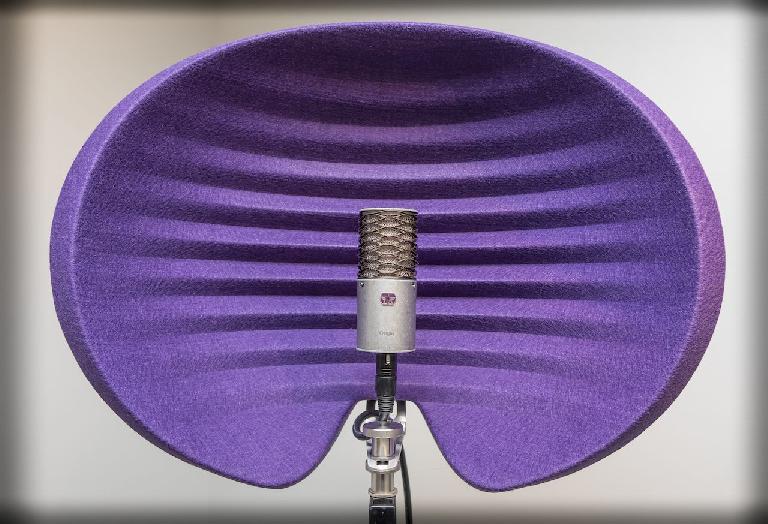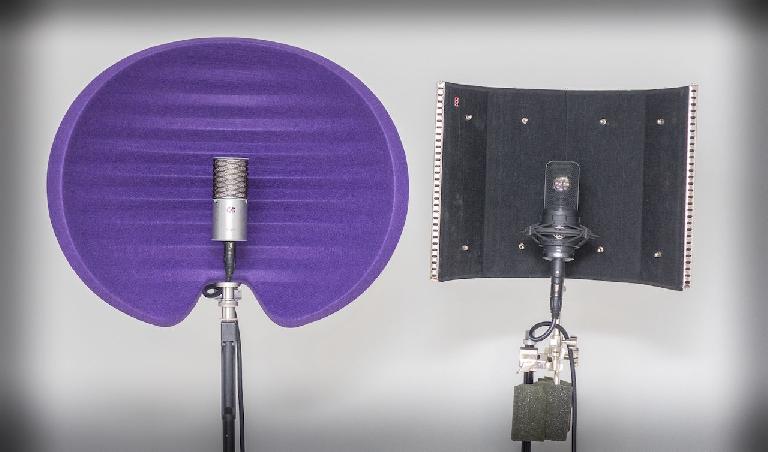Like many people, especially folks that live in apartments or smaller homes, I don’t have a dedicated vocal recording room. Sure I have treated rooms, but even they become a little more lively when recording certain vocalists or loud acoustic instruments like flamenco guitars, brass, and woodwinds. For those situations, I’ve used an sE Reflexion Filter for many years. It’s a great way to keep the early reflections from opposing walls from getting recorded back into the microphone. Such situations can sound bad, let alone cause tonal and timing anomalies when the reflected sound comes back slightly or wholly out-of-phase.
Aston Microphones have just introduced their own design called HALO. With their Origin and Spirit microphones gaining so much traction in the market, it made sense to try out HALO and pit it against my trusty sE.
A Purple Hemisphere
HALO comes in a fairly large box and when you open it, you realize that HALO is considerably larger than other reflection filters. It kind of resembles a purple clam half shell. (If Prince owned a reflection filter, it would most likely be a strikingly purple HALO.) The inside is a vibrant purple color, while the back side is more cloudy. The acoustic felt is wedged, and the body wraps around the built-in microphone post like two cupped hands holding water. (Cup your hands and put them together to see what I mean, but make sure to omit the water.)
When I took inventory of the mounting hardware, I thought I was short several pieces. As it turns out, it came with everything I needed to mount it on a mic stand: the HALO mounting bracket (already affixed to the HALO itself), a mic stand mount with counter-screw, and a mic post with holder. (Note: the stand mount has a 5/8” threading, while the post is 3/8”, so you may need some adapters to make HALO work on your mic clips, shock-mounts, and stands.) HALO is very lightweight (3.46 pounds), the patented hardware is brushed metal, and the fit is smooth and solid.
Mounting it Up
Attaching HALO to a mic stand was a breeze. One of the first things I noticed was that HALO was designed to fit directly in the center of the mic stand. This centers the weight and doesn’t tip the stand to one side, which is not something that can be said for every reflection filter on the market. (See Figure 3.) There’s also a hole in the mounting bracket through which you can thread a mic cable, and the mic post is almost 6” long when measured from the top of the threads. The center of the bracket has a cutout that allows the post to drop straight through for various height settings. (Watch your toes because it will drop all the way through, that is unless you have a 5/8” adapter or mic mounted to it.)
The Design
Once you get a mic mounted in HALO, you can see how the product wraps around the transducer from left, right, top, and bottom. This hemispherical design is ingenious for keeping out reflections from the ceiling and floor, which cannot be said of other left/right-only filters. The patented acoustic felt is made from PET and absorbs sound dramatically. Just for fun, I removed the mic and stuck my head in HALO, and it truly is quiet in there. Even the fan noise of my Mac Pro sitting directly behind me dutifully rendering an H.264 video file became noticeably quieter.
HALO vs. the sE Reflexion Filter
There’s nothing I like better than a head-to-head competition, so I used an Aston Origin microphone in both HALO and the sE and put them all in my client restroom. It has a tile floor, a glass shower door and outside window, and a large mirror on one side, so it’s an acoustic horror show. I recorded a vocal track without any filter to establish a baseline, then I recorded the same vocals separately with HALO and the sE. Interestingly, both filters seemed to change the tone of the microphone, and in both cases, for the better. But it was obvious that HALO was keeping more of the reflections out, and the mic sounded better than with the sE. HALO is also larger, and therefore rejects more reflections from more angles. You can see how much larger HALO is than the sE in Figure 3.
To hear HALO for yourself, take a listen to the following audio examples from my tests:
Recording #1: Origin without Halo:
Recording #2: Origin with Halo:
Recording #3: Origin with sE:
This test made me remember a few things I don’t like about the sE. First, it’s designed to sit off-center on the mic stand, which always tips the stand to the left or right, depending on how it’s mounted. That always makes it look crooked, and the fact that the clamp never really seats completely around the stand makes it even more crooked. (See Figure 3, and notice the foam I shove between the sE mounting post and the mic stand to minimize the tilt.) Also, the mounting hardware is reminiscent of drum hardware, and there are a lot of pieces to it including springs, wing nuts, two tiny and easy-to-lose pins, and I’ve had to use quick weld to refix the clamp nut to the mounting shaft on more than one occasion. It’s a lot to keep track of, which is why I dedicated my sE to one mic stand to reduce all that fussing. That also means it’s not easily stored away when I’m not using it, but it was a solution to a chronic problem.
On the contrary, HALO goes on and off a mic stand incredibly quickly. The few fittings it needs are machined as individual components rather than bolted together from multiple chromed tubings and grooved elbows. Even if the sE performed as well as the Aston (it didn’t), the ease and simplicity of HALO would win me over. A lot of thought went into making a very effective product, as well as how to make it a pleasure to set up. When time is of the essence, you really don’t want your client watching as you fumble to assemble your gear.
Conclusions
HALO is certainly another winner for Aston. Not only is it the best-sounding microphone reflection filter I’ve every used, it also sets a new bar for simplicity and esthetics. Granted, it’s as much or more expensive than competing high-end products (including the sE Reflexion Filter with its new lower price), but you’re certainly getting more value with HALO. Once you’ve set it up and used it, you’ll probably say to yourself, “THIS is how a refection filter should be made.”
Pros: Excellent performance, makes your mics and recordings sound better, easy to use, and provides great value.
Cons: Considering the price, it should come with a couple of 5/8” to 3/8” adapters.
List price: $349.00 ($299.00 street price)






 © 2024 Ask.Audio
A NonLinear Educating Company
© 2024 Ask.Audio
A NonLinear Educating Company
Discussion
Want to join the discussion?
Create an account or login to get started!